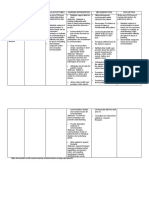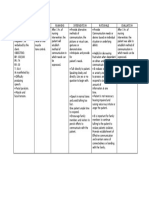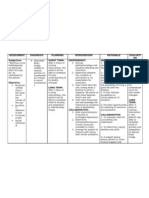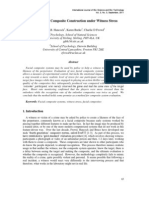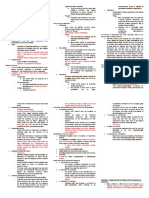0 ratings0% found this document useful (0 votes)
104 viewsNCP Cva
NCP Cva
Uploaded by
Jey PangilinanThe client has been diagnosed with a hemorrhagic stroke resulting in impaired verbal communication. Nursing interventions include monitoring vital signs, learning the client's needs through nonverbal cues, and providing a supportive environment to communicate through alternative methods like pen and paper or flash cards. The short term goal is for the client and family to understand health teachings, while long term goals include utilizing an established communication method to relate needs effectively with others.
Copyright:
© All Rights Reserved
Available Formats
Download as DOCX, PDF, TXT or read online from Scribd
NCP Cva
NCP Cva
Uploaded by
Jey Pangilinan0 ratings0% found this document useful (0 votes)
104 views3 pagesThe client has been diagnosed with a hemorrhagic stroke resulting in impaired verbal communication. Nursing interventions include monitoring vital signs, learning the client's needs through nonverbal cues, and providing a supportive environment to communicate through alternative methods like pen and paper or flash cards. The short term goal is for the client and family to understand health teachings, while long term goals include utilizing an established communication method to relate needs effectively with others.
Original Title
NCP_CVA
Copyright
© © All Rights Reserved
Available Formats
DOCX, PDF, TXT or read online from Scribd
Share this document
Did you find this document useful?
Is this content inappropriate?
The client has been diagnosed with a hemorrhagic stroke resulting in impaired verbal communication. Nursing interventions include monitoring vital signs, learning the client's needs through nonverbal cues, and providing a supportive environment to communicate through alternative methods like pen and paper or flash cards. The short term goal is for the client and family to understand health teachings, while long term goals include utilizing an established communication method to relate needs effectively with others.
Copyright:
© All Rights Reserved
Available Formats
Download as DOCX, PDF, TXT or read online from Scribd
Download as docx, pdf, or txt
0 ratings0% found this document useful (0 votes)
104 views3 pagesNCP Cva
NCP Cva
Uploaded by
Jey PangilinanThe client has been diagnosed with a hemorrhagic stroke resulting in impaired verbal communication. Nursing interventions include monitoring vital signs, learning the client's needs through nonverbal cues, and providing a supportive environment to communicate through alternative methods like pen and paper or flash cards. The short term goal is for the client and family to understand health teachings, while long term goals include utilizing an established communication method to relate needs effectively with others.
Copyright:
© All Rights Reserved
Available Formats
Download as DOCX, PDF, TXT or read online from Scribd
Download as docx, pdf, or txt
You are on page 1of 3
Client’s Diagnosis: Hemorrhagic Stroke (CVA)
Nursing Diagnosis: Impaired Verbal Communication
Assessment Diagnosis Scientific Planning Interventions Rationale Evaluation
Explanation
Subjective: “Nung Impaired Verbal A Cardiovascular Long term: Independent Independent Goal met as evidenced
kinakausap ko siya Communication related Disease (CVD), After 3 days of nursing by:
nahihirapan siyang to loss of facial muscle which may be caused interventions, the client 1. Monitor vital signs1. Establishes baseline
magsalita.” as tone or control as by hemorrhage, will be able to utilize a with emphasis to BP. data for review of -The client will have
verbalized by the sister evidenced by thrombus, embolism form or method of existing conditions. utilized a form or
of the client. expressive aphasia and or vasospasm, can communication in 2. The nurse should set method of
right-sided facial result in a local area which needs can be 2. Learn patient needs aside enough time to communication in
Objective: droop. of cell death, called expressed and to relate and pay attention to attend to all of the which needs can be
-Expressive aphasia infarct. It is caused effectively with nonverbal cues. details of patient care. expressed and to relate
-Right-sided facial by a lack of blood persons and her Care measures may effectively with persons
droop supply which is then environment such as take longer to complete and her environment
-Right-sided surrounded by an using paper and pen or in the presence of a such as using paper and
hemiparesis area of cells that are flash cards. communication deficit. pen or flash cards.
-History of CVA with secondarily affected. 3. Impaired ability to -The client and
right-sided paralysis Since symptoms Short term: communicate significant other shall
-GCS is E3, V3, M4 = depend on the After 4 hours of 3. Provide an spontaneously is have verbalized
10/15 location of the stroke nursing interventions, atmosphere frustrating and understanding of health
and size of the the client and of acceptance and embarrassing. Nursing teachings given.
infarct, it could significant other will privacy through actions should focus on
involve the brain’s be able to verbalize speaking slowly and in a decreasing the tension
Brocca’s area, which understanding of health normal tone, not forcing and conveying an
is primary teachings given. the client to understanding of how
responsible communicate. difficult the situation
for communication must be for the client.
through facial 4. Deliberate actions
expressions and can be taken to improve
speech. By causing speech. As the client’s
damage to this area, speech improves, his
the patient’s 4. Instruct techniques to confidence will
communicating skills the client to improve increase and she will
are greatly altered speech by initially make more attempts at
and affected asking questions that speaking.
(Brunner et al., client can answer with a 5. To help the client
2000). “yes” or “no”. and nurse communicate
easily.
5. Instruct to use eye
blinks or finger 6. Simple, one-action
movements for “yes” or directions enhance
“no” responses. comprehension for the
6. Provide concrete patient with language
directions that the impairment.
patient is physically
capable of doing such as 7. Improving the
“point to the pain,” client’s comprehension
“open your mouth,” can help to decrease
“turn your head”. frustration and increase
7. Utilize strategies to trust. Clients with
improve the client’s aphasia can correctly
comprehension by using interpret tone of voice.
touch and behavior to
communicate calmness
and adding other non –
verbal methods
of communication such
as pointing or using
flash cards for basic
needs; using 8. To maximize
pantomime; or using patient’s sense of
paper and pen. independence.
8. Place important 9. Practice will increase
objects within reach. the patient’s
communication.
9. Provide practice 10. Enhances
sessions within the day. participation and
10. Involve the commitment to plan.
significant others in the 11. Imparts thought and
plan of care. answers the needs of
11. Educate relatives to the client with lessened
establish a method difficulty.
of communication 12. Fatigue can make
through sign language. communication
12. Provide adequate difficult or impossible.
time to rest. Dependent
13. To promote
Dependent recovery.
13. Administer and 14. To decrease blood
regulate IVF as ordered. pressure.
14. Administer anti-
hypertensive medication Interdependent
as ordered. 15. Specialized services
may be required to
Interdependent meet needs.
15. Refer to appropriate
resources such as speech
therapist, group therapy,
individual/family and/or
psychiatric counseling.
Reference:
Brunner, L. S., Smeltzer, S. C., Suddarth, D. S., Smeltzer, S. C., & Bare, B. G. (2000). Brunner and Suddarth's textbook of medical-surgical nursing (9th ed.). Lippincott Raven.
You might also like
- Nursing Care Plan AutismDocument3 pagesNursing Care Plan Autismangeliejoy_110976% (29)
- Mangerial EscalatorDocument6 pagesMangerial EscalatorHi Bye50% (4)
- INBDEBooster Patient Management NotesDocument19 pagesINBDEBooster Patient Management NotessuryathatiNo ratings yet
- NCP Impaired Verbal CommunicationDocument2 pagesNCP Impaired Verbal CommunicationLovelie Grace Galarpe100% (3)
- Nursing Care Plan Cerebrovascular Accident (CVA)Document1 pageNursing Care Plan Cerebrovascular Accident (CVA)deric97% (34)
- Impaired Verbal CommunicationDocument1 pageImpaired Verbal Communicationdana100% (3)
- Support Animal Form 11-3-15Document1 pageSupport Animal Form 11-3-15HSelmon88No ratings yet
- Nursing Care Plan For Cerebrovascular AccidentDocument4 pagesNursing Care Plan For Cerebrovascular AccidentJobelle AcenaNo ratings yet
- As Needed.: Environmental Stimuli 6Document4 pagesAs Needed.: Environmental Stimuli 6Nicole GumolonNo ratings yet
- Cerebrovascular Accident (CVA) N C P BY BHERU LALDocument1 pageCerebrovascular Accident (CVA) N C P BY BHERU LALBheru LalNo ratings yet
- Assessment Nursing Diagnosis Planning Intervention Rationale Evaluation Subjective: Short Term: Independent: Short TermDocument3 pagesAssessment Nursing Diagnosis Planning Intervention Rationale Evaluation Subjective: Short Term: Independent: Short TermhelloaNo ratings yet
- Cues Nursing Diagnosis Goals/Outcomes Nursing Intervention Implementation Evaluation SubjectiveDocument5 pagesCues Nursing Diagnosis Goals/Outcomes Nursing Intervention Implementation Evaluation SubjectiveRyan MirandaNo ratings yet
- Bells Palsy NCPDocument3 pagesBells Palsy NCPLeonardo Martin FrivaldoNo ratings yet
- verbalDocument2 pagesverbalalobbagwyneth225No ratings yet
- Assessment Diagnosis Planning Intervention Rationale EvaluationDocument1 pageAssessment Diagnosis Planning Intervention Rationale EvaluationALIANA KIMBERLY MALQUESTONo ratings yet
- Assessment Diagnosis Planning Intervention Rationale EvaluationDocument2 pagesAssessment Diagnosis Planning Intervention Rationale EvaluationALIANA KIMBERLY MALQUESTONo ratings yet
- Date Cues Nsg. DX Scientific Basis Goal of Care NSG Intervention Rationale EvaluationDocument4 pagesDate Cues Nsg. DX Scientific Basis Goal of Care NSG Intervention Rationale EvaluationWenalyn Grace Abella LlavanNo ratings yet
- NCP Klinefelter Syndrom (Dumagal)Document2 pagesNCP Klinefelter Syndrom (Dumagal)Criza May DumagalNo ratings yet
- Sam MyDocument1 pageSam MySammy D. SanoriaNo ratings yet
- Impaired Verbal CommunicationDocument2 pagesImpaired Verbal CommunicationMart AlunanNo ratings yet
- NCM117 Rle TopicsDocument3 pagesNCM117 Rle TopicsEzra AlexandriaNo ratings yet
- Case Study 1Document2 pagesCase Study 1Blessie AgananNo ratings yet
- Essentials of Psychiatric Mental Health Nursing Concepts of CareDocument1 pageEssentials of Psychiatric Mental Health Nursing Concepts of CareEno AlNo ratings yet
- 5 NCP - OsanoDocument11 pages5 NCP - OsanoOsano CatherineNo ratings yet
- Focus Action ResponseDocument3 pagesFocus Action ResponseJesselyn CampitNo ratings yet
- Impaired Verbal CommunicationDocument3 pagesImpaired Verbal CommunicationChenee Mabulay100% (1)
- Assessment Diagnosis Planning Intervention Rationale EvaluationDocument6 pagesAssessment Diagnosis Planning Intervention Rationale EvaluationRichmond RocesNo ratings yet
- DiagnosisDocument7 pagesDiagnosisjhilltotNo ratings yet
- NCPDocument7 pagesNCPBesael BaccolNo ratings yet
- Communication: Reference: Group 1'S PPT / Kozier'S Book: Chapter 26Document3 pagesCommunication: Reference: Group 1'S PPT / Kozier'S Book: Chapter 26HNo ratings yet
- Communication With Vulnerable GroupsDocument3 pagesCommunication With Vulnerable GroupssunepwalawallingwallingNo ratings yet
- Aetcom NDDocument7 pagesAetcom NDbansiwalchanchal220100% (1)
- ComunicaciónDocument16 pagesComunicaciónkarinaNo ratings yet
- Group NCPDocument17 pagesGroup NCPNiña Noreen Torres VallegaNo ratings yet
- Nursing Care Plan CVADocument4 pagesNursing Care Plan CVAhermesdave175% (4)
- NCPDocument5 pagesNCPDenise GabatoNo ratings yet
- Assessment NX Diagnosis Planning Intervention Rationale EvaluationDocument4 pagesAssessment NX Diagnosis Planning Intervention Rationale EvaluationLady Daphne LandichoNo ratings yet
- 3 Nursing Care PlanDocument6 pages3 Nursing Care PlanJeyser T. GamutiaNo ratings yet
- NCP Ni My RoseDocument2 pagesNCP Ni My RoseHaru chuchuNo ratings yet
- Disturbed Body ImageDocument2 pagesDisturbed Body ImageJohanna Elaine Tandoc50% (2)
- Needs/ Problems/Cues Nursing Diagnosis Scientific Basis Objectives of Care Nursing Actions RationaleDocument1 pageNeeds/ Problems/Cues Nursing Diagnosis Scientific Basis Objectives of Care Nursing Actions RationaleHarold PeranduzNo ratings yet
- NCM 101 - Continuation of InterviewDocument4 pagesNCM 101 - Continuation of InterviewJohn Paul MolinaNo ratings yet
- NCP Fear PDF Relaxation (Psychology) Positive Psychology 2Document1 pageNCP Fear PDF Relaxation (Psychology) Positive Psychology 2BERSAMERA JOVEN 1CNo ratings yet
- 117 Rle 3m MergedDocument55 pages117 Rle 3m Mergedalaisahmae02No ratings yet
- Nursing Care Plan: Ellen Adarna, Borikat Na Siya. Ga Igat Igat Lang Na Siya"Document2 pagesNursing Care Plan: Ellen Adarna, Borikat Na Siya. Ga Igat Igat Lang Na Siya"dubouzettheresaNo ratings yet
- Nueva Ecija University of Science and Technology: O V A ADocument16 pagesNueva Ecija University of Science and Technology: O V A AKym RonquilloNo ratings yet
- Breaking Bad News - ReflectionDocument6 pagesBreaking Bad News - ReflectionUZNAPM50% (2)
- 4.01-PDR-Physician Communication SkillsDocument5 pages4.01-PDR-Physician Communication SkillsJoher MendezNo ratings yet
- Nursing Care Plan: Lorma Colleges Con Template Related Learning ExperienceDocument4 pagesNursing Care Plan: Lorma Colleges Con Template Related Learning ExperienceMark Jason GalangNo ratings yet
- CommunicationDocument5 pagesCommunicationsummer.monthxxNo ratings yet
- The Practitioners Handbook To Patient Communication From Theory To Practice: The Practitioners Handbook To Patient Communication From Theory To Practice, #4From EverandThe Practitioners Handbook To Patient Communication From Theory To Practice: The Practitioners Handbook To Patient Communication From Theory To Practice, #4No ratings yet
- "What I Mean Is..." A Structured Program to Improve Mild to Moderate Retrieval/Fluency Problems 3rd EditionFrom Everand"What I Mean Is..." A Structured Program to Improve Mild to Moderate Retrieval/Fluency Problems 3rd EditionRating: 5 out of 5 stars5/5 (1)
- The Practitioners Handbook To Patient Communication From Theory To Practice: The Practitioners Handbook To Patient Communication From Theory To Practice, #3From EverandThe Practitioners Handbook To Patient Communication From Theory To Practice: The Practitioners Handbook To Patient Communication From Theory To Practice, #3No ratings yet
- The Practitioners Handbook To Patient Communication From Theory To Practice: The Practitioners Handbook To Patient Communication From Theory To Practice, #2From EverandThe Practitioners Handbook To Patient Communication From Theory To Practice: The Practitioners Handbook To Patient Communication From Theory To Practice, #2No ratings yet
- Listen, Speak, Lead: Elevate Your Success with Effective CommunicationFrom EverandListen, Speak, Lead: Elevate Your Success with Effective CommunicationNo ratings yet
- Suggestion Therapeutic (Translated): Diseases treated by means suggestive and hypnoticFrom EverandSuggestion Therapeutic (Translated): Diseases treated by means suggestive and hypnoticNo ratings yet
- How to Speak Nicely with Anyone: Your Guide to Effective Communication MasteryFrom EverandHow to Speak Nicely with Anyone: Your Guide to Effective Communication MasteryNo ratings yet
- Communicating in Dental Practice: Stress-Free Dentistry and Improved Patient CareFrom EverandCommunicating in Dental Practice: Stress-Free Dentistry and Improved Patient CareRating: 5 out of 5 stars5/5 (1)
- How Can Holistic Health Benefit MeDocument2 pagesHow Can Holistic Health Benefit Meanna ticaNo ratings yet
- Dictionary of Human ResourcesDocument27 pagesDictionary of Human ResourcesAsif Abdul HaqNo ratings yet
- Survey QuestionnaireDocument3 pagesSurvey QuestionnairendordellyNo ratings yet
- English A EssayDocument1 pageEnglish A Essaypatrobloxgaming15No ratings yet
- Unit of Study PumpkinsDocument4 pagesUnit of Study Pumpkinsapi-282290567No ratings yet
- Phosphenic Mixing BrochureDocument7 pagesPhosphenic Mixing BrochureDeris Bogdan IonutNo ratings yet
- Learning Modules: Lourdes CollegeDocument2 pagesLearning Modules: Lourdes Collegematthew lomongoNo ratings yet
- For Handout B.F. SkinnerDocument6 pagesFor Handout B.F. Skinnermarinel juneNo ratings yet
- Testing Facial Composite Construction Under Witness Stress: Peter J.B. Hancock, Karen Burke, Charlie D FrowdDocument8 pagesTesting Facial Composite Construction Under Witness Stress: Peter J.B. Hancock, Karen Burke, Charlie D Frowdapi-61200414No ratings yet
- Case StudyDocument10 pagesCase StudyRonnamay LobasNo ratings yet
- Narrative Report in Demonstration Teaching in MathematicsDocument1 pageNarrative Report in Demonstration Teaching in MathematicsEy Sy100% (2)
- Writing A Formalist Literary AnalysisDocument5 pagesWriting A Formalist Literary AnalysisRey Cabrido RoseteNo ratings yet
- Literature Review Attachment TheoryDocument8 pagesLiterature Review Attachment Theoryaflshvifm100% (1)
- CHAPTER 1 Human BehaviorDocument146 pagesCHAPTER 1 Human BehaviorHanz MoralesNo ratings yet
- EXISTENTIALISM in EducationDocument40 pagesEXISTENTIALISM in EducationCritical ViewNo ratings yet
- Tat Needs Presses PDFDocument8 pagesTat Needs Presses PDFrichieerishiNo ratings yet
- Chapter 1: Introduction To Personality TheoriesDocument34 pagesChapter 1: Introduction To Personality TheoriesAnne NicoleNo ratings yet
- KNN - 2019 - Chapter 4 - Management and Cultural DiversityDocument15 pagesKNN - 2019 - Chapter 4 - Management and Cultural DiversityYến NhiNo ratings yet
- Reasons Why We Use Visual Thinking For Problem SolvingDocument7 pagesReasons Why We Use Visual Thinking For Problem SolvingakhilNo ratings yet
- What Type of Student Are YouDocument3 pagesWhat Type of Student Are Youapi-259860195No ratings yet
- DBDA ManualDocument25 pagesDBDA Manualastuti sharmaNo ratings yet
- Digital HabitsDocument3 pagesDigital HabitsAboodi Bin MuhamedNo ratings yet
- Conclusion: Valerie WalkerdineDocument4 pagesConclusion: Valerie WalkerdinebobyNo ratings yet
- Teacher CollaborationDocument11 pagesTeacher Collaborationapi-483586558100% (2)
- Art and SoulDocument38 pagesArt and SoulViviana CéspedNo ratings yet
- The Investment Model Scale: Measuring Commitment Level, Satisfaction Level, Quality of Alternatives, and Investment SizeDocument35 pagesThe Investment Model Scale: Measuring Commitment Level, Satisfaction Level, Quality of Alternatives, and Investment SizeAgnesYolandaNo ratings yet
- RM 310 3 FLR Abalos Bldg. Gen. Aguinaldo St. Iligan CityDocument12 pagesRM 310 3 FLR Abalos Bldg. Gen. Aguinaldo St. Iligan CityDhena H Rasul SabdulaNo ratings yet
- Management: The Attainment of Organizational Goals in An Effective and Efficient Manner ThroughDocument31 pagesManagement: The Attainment of Organizational Goals in An Effective and Efficient Manner Throughsuraj sharma 222No ratings yet











